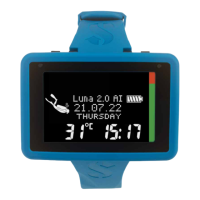64
LUNA 2.0 AI USER MANUAL
During a no-stop dive, as soon as you reach that depth during an ascent, a 2-minute countdown will appear.
You can have one of these 3 situations:
1. You have spent 2 minutes within 3m/10ft above the indicated depth. The countdown timer disappears, and
you have successfully completed the PDIS.
2. You have descended more than 0.5m/2ft below the PDIS. The countdown timer disappears and will reappear
again, starting at 2 minutes, the next time you ascend to the PDIS depth.
3. You have ascended more than 3m/10ft above the PDIS. The PDIS value and countdown timer disappears and
PDIS has not been performed.
F
NOTE: The LUNA 2.0 AI issues no warnings relating to a missed PDI stop. When diving with MB-levels, PDIS
follows the same rules as described above. MB-levels, however, introduce stops earlier and deeper than the L0
base algorithm. As such, the PDIS display may be delayed and, for certain dives, it may not be displayed at all.
This, for example, would be the case for a shallow dive with air (21% oxygen) and a MB-level L5.
3 .16 Diving with Gradient Factors (GF)
The technical diving community, in particular, nds that the Gradient Factors approach best suits their diving needs.
So, in an effort to address these preferences the LUNA 2.0 AI’s software can be set to use GF settings.
Bühlmann created the ZH-L16C base algorithm. In the 90’s Erik Baker presented the Gradient Factors (GF)
approach, which provides additional options for increased conservatism. Gradient Factors can be set from no
conservatism at all (100/100) to many different combinations.
In the Gradient Factor format “low/high” both values “low” and “high” present the percentual amount of the base
algorithm limiting M-value. The “low” denes the conservatism on fast compartments which will start desaturation at
ascent rst, whereas the “high” becomes dominant on shallower depths before surfacing. Due to the many possible
combinations, it is possible to dene your own decompressing strategy.
F
NOTE: For a more detailed explanation of the Gradient Factors and their meaning, please refer to Erik Baker’s
articles: “Clearing Up the Confusion About Deep Stops” and “Understanding M-values”.
WARNING
Diving with the Gradient Factor algorithm requires advanced know-how about decompression theories, their suitability for the
planned dives and matching to your body. Wrong values can lead to decompression sickness, severe injury or death. Do not
dive with Gradient Factors until you have the necessary knowledge and qualications!

